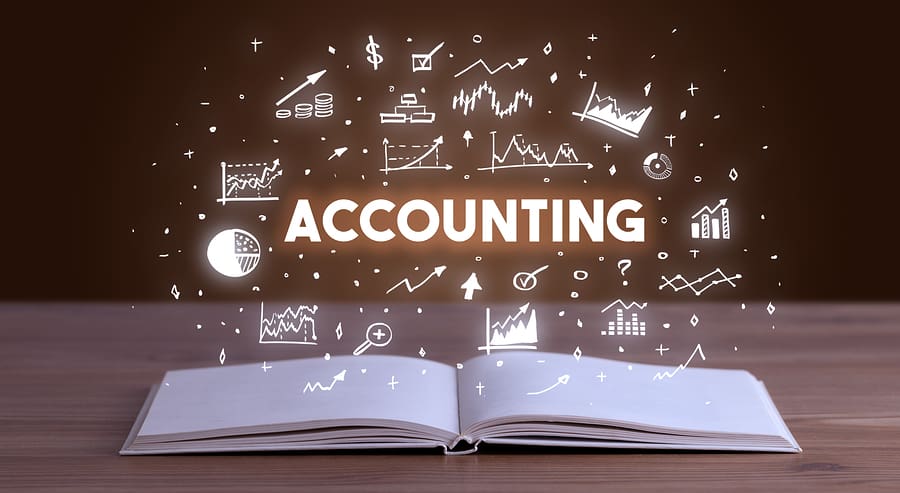The 60 Accounting Terms You Need To Know
Whether you're a small business owner or student, here are the 60 accounting terms, abbreviations, and definitions you need to know.

Accounting terms can be complicated. Because of that, we’ve created this ultimate guide of the 60 most basic accounting terms business owners and students alike need to know. We’ve broken down complicated accounting terms and abbreviations with clear and concise definitions so that researching these accounting concepts won’t leave you scratching your head.
Let’s jump right in.
Table of Contents
What Is Accounting?
There are several definitions for accounting. However, the simplest definition of accounting is that it is understanding, recording, and analyzing financial transactions. For a deeper look into accounting, check out our accounting eBook for beginners.
With an understanding of what accounting is, keep reading for more common terms you’ll encounter in your research and use of accounting software.
60 Basic Accounting Terms & Definitions
Accounting can be overwhelming, so here is a list of the most basic accounting terms with easy-to-understand definitions. Whether you’re a business owner or a student, here is the ultimate list of accounting terms and definitions.
1. Accountant
Someone trained to properly keep, report, and inspect financial records and transactions.
2. Accounting Equation
To minimize mistakes in your accounting, you’ll want to utilize this equation. It is merely:
assets = equity + liabilities
or
assets – liabilities = equity
The primary rule of this equation is that both sides must balance out (you’ve probably heard of “balancing the books” — this is where that phrase comes from). This means that if one half is greater or less than the other, there’s an error in your calculations.
3. Accounts
These are places to record specific transactions, such as those involving cash or loans. Accounts are frequently split into five categories: assets, liabilities, equity, revenue, or expenses.
4. Accounts Payable (AP)
When your business buys a product or service on credit and has not paid for it yet, the expense is recorded under accounts payable.
5. Accounts Receivable (AR)
When your business has delivered a product or service, but your buyer has not paid for it yet, it is recorded under accounts receivable.
6. Accrual Accounting
A business records income when products/services are incurred or agreed upon.
For example, if a business sends an invoice on May 10 and is paid on June 10, but counts the payment for May, that is accrual-based accounting.
7. Accrued Expenses
Accrued expenses are expenses that are recorded before they are paid. These expenses will be paid in the future.
Examples of accrued expenses include salaries, bonuses, and customer returns.
Jump down to “expenses.”
8. Amortization
A technique utilized to gradually and periodically reduce the cost of a loan, intangible asset, or other debt.
9. Assets
Anything (cash, inventory, equipment, etc.) your business owns. Assets are broken up into two categories: fixed assets and current assets.
Jump back up to “accounts.”
10. Audit
The examination of your business’s accounting records and physical assets because you believe a mistake or discrepancy exists and needs to be verified.
11. Balance Sheet
An accounting report that calculates assets, liabilities, and equity to make sure both sides of the accounting equation match.
12. Bookkeeper
Someone who is in charge of maintaining your business’s books. They handle the business’s finances on a day-to-day basis.
13. Bookkeeping
The act of recording the accounts, financial transactions, and other information related to your business.
14. Capital
The financial assets your business owns, which can include monetary funds as well as physical entities, such as manufacturing equipment or buildings.
15. Cash Flow (CF)
The money that is going in and out of your business. Cash flow includes cash inflows and cash outflows.
- Cash Inflow: Cash that comes into your business (ex. sales, interest earned, etc.).
- Cash Outflow: Cash that leaves your business (ex. employee paychecks, inventory purchases, etc.).
16. Cash Flow Statement
This financial statement provides a summary of the in-going and out-going cash in a business during a set timeframe.
17. Cash-Basis Accounting
A business records income when products/services are paid for.
For example, if you send an invoice on May 10, get paid on June 10, and count that money for June, you’re using cash-based accounting.
18. Certified Public Accountant (CPA)
Those with a CPA qualification have more credibility and expertise than regular accountants. A CPA can create audits and review reports as well as legally represent your business in front of the IRS — two things a regular accountant can’t do.
19. Chart Of Accounts
A report that lists all user accounts in a general ledger. Because this chart is made up of accounts, you’ll often see five categories: assets, liabilities, equity, income, and expenses. A four-digit numbering system is used to organize these accounts.
A chart of accounts lets you organize and track specific business information. It gives you a clear picture of where your money is going and provides you with the necessary information to make informed business decisions in the future. The chart of accounts is also the basis for all accounting reports and is useful when filling out your Schedule C at tax time.
Most modern accounting software will set up a chart of accounts for you based on your industry and business type. You will simply need to delete unnecessary accounts, rename confusing accounts, and add your opening balances. However, you may choose to set up your own chart of accounts.
20. Cloud-Based
You may see this term in conjunction with cloud software. If something is “cloud-based,” it is usually accessed via the internet and hosted on remote servers.
Cloud-based accounting is becoming the most accounting option for small business owners because of its ease of use and accessibility. Almost all of our top small business accounting software choices are cloud-based.
Jump down to “locally-installed.”
21. Contra Accounts
These accounts are used in a general ledger and come with a balance opposite the normal balance for a related account. If the related account has a debit, the contra account will record a credit. Note that your accounting software will likely handle all this behind the scenes, so you probably won’t come into contact with contra accounts in the wild.
22. Cost Of Goods Sold (COGS)
Cost of goods sold refers to any cost related to making or assembling items or services you sell. Generally, the total is calculated by summing up the amount you spent on inventory and labor.
23. Credits
Credits are accounting entries that decrease assets or expenses and increase liabilities. Credits are always on the right side of the T-Account used for recording all accounting transactions.
24. Current Assets
Short-term assets are made up of cash plus any other assets that will become cash during the fiscal year (like inventory or accounts receivable).
Jump back up to “assets“.
24. Debits
Debits are accounting entries that increase assets or expenses and decrease liabilities. Debits are always on the left side of the T-Account used for recording all accounting transactions.
25. Depreciation
This term looks at the loss of value in an asset during its time in use. You’ll often consider depreciation when looking at vehicles, manufacturing equipment, or other physical assets that decrease in value over time. Depreciation can be utilized as a tax deduction by calculating how much a specific asset has depreciated from its initial value (rather than writing off the entire expense at once).
26. Double-Entry Accounting
Double-entry accounting is a type of accounting where every transaction is recorded at least twice, both as credit and debit. In double-entry accounting, debits must always equal credits.
This type of accounting is preferred by experts and gives a clear picture of a business’s financial health. Double-entry accounting helps catch errors, creates strong accounting records, and makes it easier to prepare financial documents. Most modern accounting software uses double-entry accounting.
Double-entry accounting is the only way to get an accurate view of your company’s finances. Single-entry accounting records income and expenses alone, whereas double-entry accounting takes assets and liabilities into account, giving you a more complete balance sheet.
27. Enterprise Resource Planning (ERP)
Enterprise resource planning is a process meant to help you manage and consolidate the key parts of your business. ERP software is a step up from accounting software and, in addition to accounting, adds other key enterprise business features, such as payroll, advanced reporting, and human resources.
28. Equity
Equity refers to a business’s worth or the value of the owner’s investment in that business. When an owner has assets invested in the company, you can calculate the value of their investment using the basic accounting equation:
assets = equity + liabilities
or
assets – liabilities = equity
Jump back up to “accounts.”
29. Estimate
A calculation of a financial transaction where no precise value can be determined. Estimates are often made based on expert judgment, background knowledge, and historical data.
30. Expenses
The costs to run your business. Expenses can be broken into four categories: fixed expenses, variable expenses, accrued expenses, and operating expenses.
Jump back up to “accounts.”
31. Fixed Assets
Assets with a long-term life that won’t be used up in a single fiscal year (property, equipment, company vehicles, etc.).
Jump back up to “assets.”
32. Fixed Expenses
Fixed expenses cost the same amount each month. Examples include rent, property taxes, or insurance premiums.
Jump back up to “expenses.”
33. General Ledger
The basis for all accounting reports. Tracks all financial transactions.
34. Gross Profit
Your business’s income from sales, minus COGS. This number can be used to help determine the health of your business. You’ll usually see gross profits on your company’s income statement, as well as pretty much any business tax form.
25. Invoice
An itemized list of rendered goods or services detailing the price and terms of sale. The seller sends it to the buyer.
36. Job Costing
A method where you calculate the costs and profitability of each job performed for your customers.
Job costing considers all costs associated with providing a service and is used when calculating the cost of a service or product that is unique to a customer.
37. Journal Entries
Journal entries are utilized to record business transactions and organize all related accounts affected by a transaction.
Journal entries are made in the general ledger report; however, the journal entries themselves are not necessarily a report.
The journal itself is ordered chronologically.
38. Liabilities
Any debts owed by the business.
Jump back up to “accounts.”
39. Liquidation
The act of dissolving a business by converting assets into cash to pay off debts.
40. Locally-Installed
If you have locally-installed software, then the program is installed on the hard drive of your local computer, tablet, or phone. This contrasts with cloud-based software that you access via a web browser.
Note: locally-installed software may still require internet access (such as to verify your product’s license).
41. Net 30
Net refers to the length of time a customer has to pay a bill before its due date, which in this case would be 30 days.
The clock starts ticking on the date the invoice was sent. You may also see “Net 15” or “Net 10”, which means a customer would have to pay within 15 or 10 days, respectively.
By setting due dates on invoices, customers may be more likely to pay invoices faster.
42. Net Profit
Your business’s gross profit minus taxes, interest, depreciation, and various other expenses.
Note that net profit subtracts all operating expenses from your income via sales. It’s the true profit of your business. While gross profit measures the health of your business, net profit simply measures its profitability.
43. Operating Expenses
Operating expenses are expenses that are paid as part of a business’s day-to-day operations. This includes equipment, inventory, payroll, and marketing costs.
Jump back up to “expenses.”
44. Payroll
Payroll is a list of employees and the hourly wage or salary they are to be paid. Payroll also refers to the entire process by which employers pay their employees.
45. Profit & Loss Report (P&L)
An accounting report that calculates a business’s profit by subtracting COGS from income.
46. Proposal
A submission by a potential customer or vendor proposing to buy or sell goods or services.
47. Purchase Order
A commercial document submitted by a buyer requesting a vendor or supplier to provide goods and/or services.
48. Quote
A document provided by the vendor or supplier detailing a list of proposed prices for goods or services. Quotes may be generated based on the individual needs of a particular customer.
49. Reconciliation
The act of comparing two numbers (usually account balances or other financial records) and making sure things line up. Reconciling your accounts can help you spot errors, fraud, or other problems with your books.
50. Return On Investment (ROI)
Return on investment is expressed as a percentage and is calculated with this equation:
ROI = (gain of investment – cost of investment) / cost of investment
This formula demonstrates how successful your investment was by showing the profit gained or lost.
51. Revenue
Profit earned by your company (usually through sales).
Jump back up to “accounts.”
52. Sales Order
A document written by a seller that is sent out after receipt of a customer’s purchase order. It essentially confirms the sale of goods or services.
53. Single-Entry Accounting
A type of accounting that records income and expense accounts only. This is simpler than double-entry accounting but gives a less complete view of your company.
54. Software As A Service (SaaS)
Software as a service is a business model where users don’t buy the software outright but are paying a subscription to access the software service on a continuous basis. These payments are usually monthly, and the software is often cloud-based.
55. Solvency
Your business’s ability to pay long-term debts and financial obligations.
56. Tax Deduction
Tax deductions are expenses individuals and businesses can “write off,” meaning they can count certain expenses against their taxable income. By lowering taxable income through deductions, individuals and business owners are able to reduce the amount of taxes they owe.
Jump back up to “depreciation“.
57. Taxes
Taxes are contributions mandated by the local, state, and/or federal government that individuals and business owners must pay every year (sometimes more frequently, such as self-employed taxes or payroll taxes).
58. Trial Balance
A list of all balances of all accounts found within the chart of accounts. This report also includes your total debits and total credits.
Numbers within this trial balance should match; if they don’t, then your books aren’t balanced.
59. Variable Expenses
Variable expenses fluctuate over time.
Examples of variable expenses include: electricity, water, gas, maintenance, and repairs.
Jump back up to “expenses.”
60. Year-End Accounting
Year-end accounting is the process of closing the books by making sure all accounts are balanced, and all income, revenue, expenses, assets, and liabilities have been properly recorded.
Learn More: How To Apply Accounting Terms
Now, you should have a better grasp of the most common accounting terms and definitions. If you’re still keen to sharpen your accounting knowledge, our free The Beginner’s Guide To Accounting eBook is a great place to start.
Or, if you’re looking for some accounting software for your business, check out one of our accounting reviews or take a peek at our picks for the best accounting software for small businesses.










